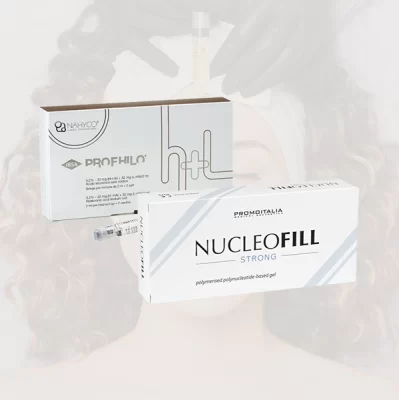Nucleofill or Profhilo?
- What are Nucleofill and Profhilo and how do they work?
- What are the main differences in composition and mechanism of action?
- When to choose Nucleofill and when Profhilo?
- What effects can be expected after both procedures?
- How do Nucleofill and Profhilo procedures differ and what is the process of each?
- What are the contraindications for procedures and possible side effects of their performance?
- How much do the treatments cost and how long do the effects last?
Nucleofill and Profhilo are modern tissue biostimulators widely used in aesthetic medicine. Their main task is deep skin renewal. They work by stimulating fibroblasts - cells responsible for the production of collagen and elastin.
Nucleofill provides lifting, acts antioxidatively, as well as intensely moisturizes and supports skin regeneration. On the other hand, Profhilo focuses on tissues bioremodeling, restoring the skin's natural scaffolding.
Both preparations effectively initiate biorevitalization processes, leading to natural rejuvenation of the skin and improving its condition, without altering facial features.
The key differences between Nucleofill and Profhilo stem from their composition and mechanism of action. Nucleofill is based on natural polynucleotides, which are DNA and RNA fragments. These activate fibroblast receptors, intensely stimulating the production of collagen type I. Additionally, these bioactive molecules act as antioxidants, neutralizing free radicals and reducing oxidative stress. Moreover, they bind water, ensuring good skin hydration.
Profhilo, on the other hand, relies on unique, stabilized complexes of hyaluronic acid with a high concentration (64 mg). The secret to its effectiveness lies in the slow, gradual penetration of hyaluronic acid deep into the tissues, providing intense skin hydration, stimulating fibroblasts to produce collagen and elastin, facilitating effective tissue remodeling, and restoring the skin's natural scaffolding.
The choice between Nucleofill and Profhilo procedures is always an individual matter, closely dependent on the patient's skin condition. The final decision is made by the doctor during a detailed consultation with the patient.
Nucleofill is the ideal solution for dehydrated, oxygen-deprived, and oxidatively stressed skin. It effectively slows down the appearance of the first signs of aging. Moreover, its special variants excellently reduce dark circles and swelling under the eyes, providing a comprehensive improvement in the appearance of the delicate eye area.
Profhilo is recommended when dealing with significant skin laxity, loss of facial contour, or the appearance of so-called "marionette lines." This innovative product actively remodels tissues, rebuilding the skin's natural scaffolding. Therefore, it delivers a strong lifting effect and noticeably improves skin tension, restoring a youthful appearance.
The Nucleofill procedure visibly firms and elasticizes the skin. Thanks to it, the skin regains a uniform tone, and fine wrinkles become less visible. Profhilo works differently, focusing on contouring the face. It not only smoothes wrinkles but also gives the skin a unique glow, often referred to as the "wet skin" effect. Both treatments provide natural and gradual skin rejuvenation. Their long-lasting results are the effect of deep, internal skin remodeling.
The treatments Nucleofill and Profhilo, although both effectively rejuvenate the skin, differ mainly in the techniques of applying the products.
Profhilo is administered using the innovative BAP (Bio Aesthetic Points) method, which involves just five precise injections on each side of the face. This approach minimizes patient discomfort and significantly shortens the recovery time after the procedure.
Nucleofill is administered differently. It can be applied to bioaesthetic points using a needle or cannula, often involving more punctures. Due to the method of product application, the procedure somewhat resembles mesotherapy. Regardless of the chosen product, a single treatment session is always quick.
To achieve optimal and long-lasting results, specialists typically recommend a series of treatments at specific intervals.
Nucleofill and Profhilo treatments are widely considered to be safe and generally well-tolerated by patients. However, an initial consultation with a doctor is always necessary to exclude any contraindications to these procedures. Key contraindications include:
- Pregnancy,
- Breastfeeding,
- Active cancer,
- Untreated autoimmune diseases,
- Active skin infections, such as herpes in the area of the planned treatment,
- Tendency to form keloids,
- Blood clotting disorders.
Any potential side effects after the treatments are usually mild and quickly resolve. The most common observations include redness, slight swelling, tenderness, or minor bruising at the injection site. Serious complications are extremely rare. Recovery after the procedure is short, allowing patients to quickly return to their daily activities.
The price of treatments depends on several important factors, such as the type of selected product, the location of the office, and the experience of the specialist. For optimal and long-lasting results, a series of treatments is often recommended, which affects the total cost.
With Profhilo, effects are typically visible for 12-18 months. In the case of Nucleofill, results often last for many months, sometimes even up to 1 year.

